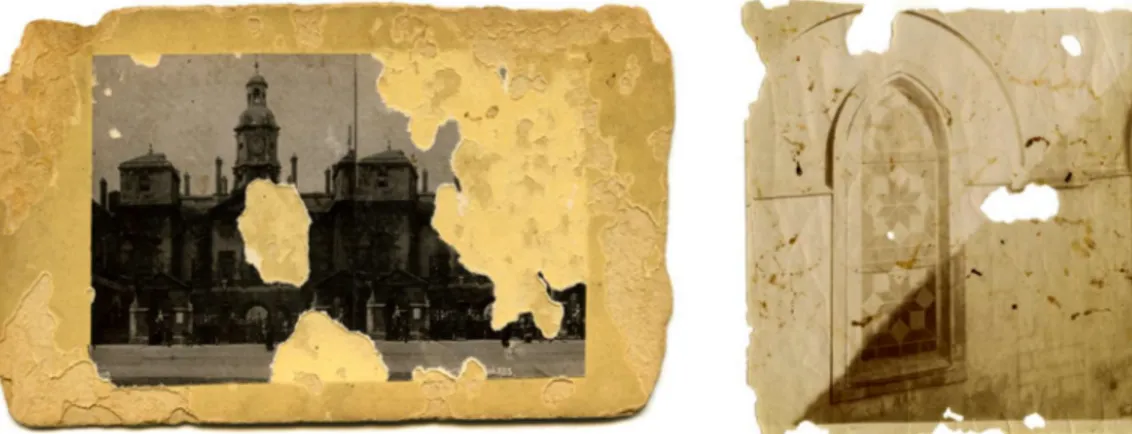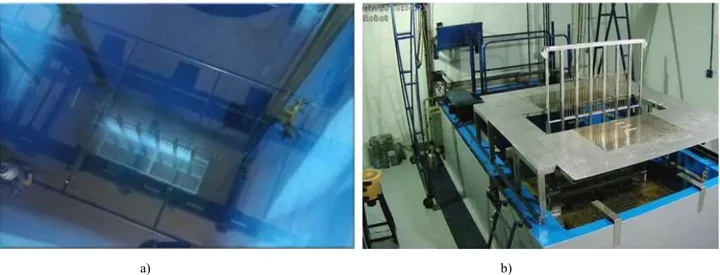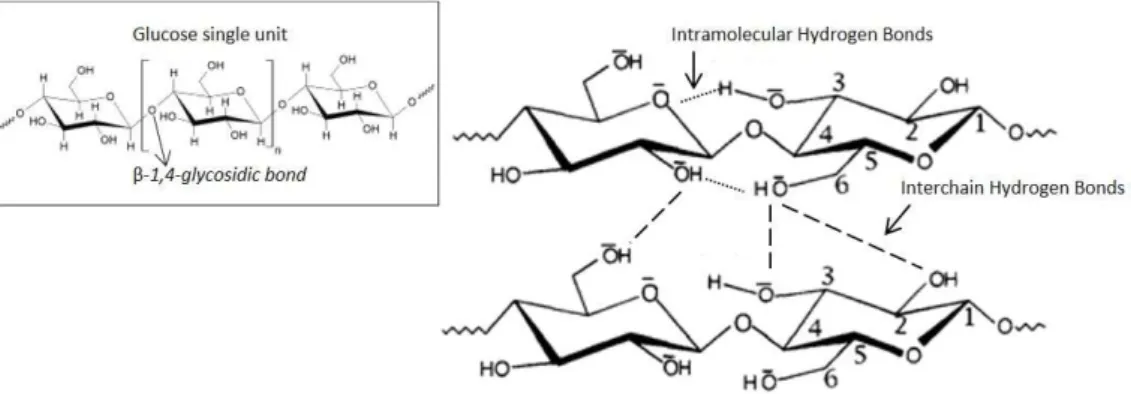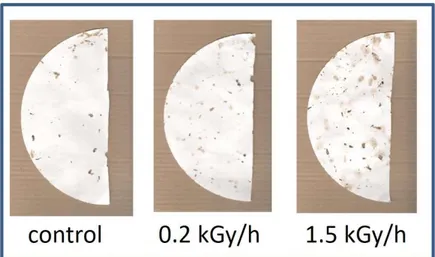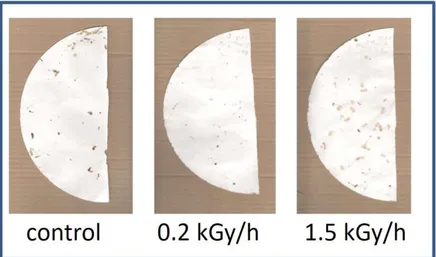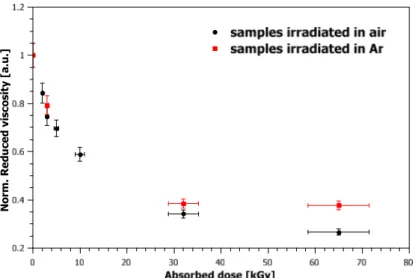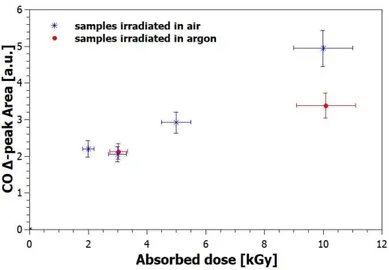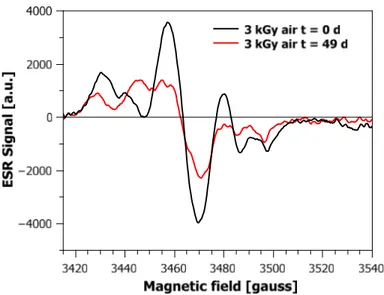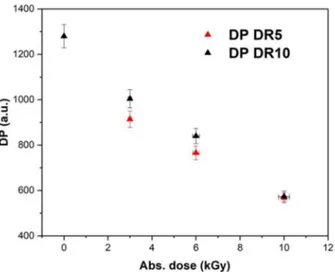CULTURAL HERITAGE PRESERVATION AND
CONSERVATION OF ARCHIVED MATERIALS:
GAMMA RADIATION PROCESSING AND
CHARACTERIZATION AT THE CALLIOPE FACILITY
(CASACCIA R.C., ROME - ITALY)
A. CEMMI, I. DI SARCINA, G. FERRARA Fusion and Technology for Nuclear Safety
and Security Department Casaccia Research Centre,Rome - Italy
IS SN /2 49 9-53 47 RT/2020/1/ENEA
ITALIAN NATIONAL AGENCY FOR NEW TECHNOLOGIES, ENERGY AND SUSTAINABLE ECONOMIC DEVELOPMENT
A. CEMMI, I. DI SARCINA, G. FERRARA
Fusion and Technology for Nuclear Safety and Security Department Casaccia Research Centre, Rome - Italy
CULTURAL HERITAGE PRESERVATION AND
CONSERVATION OF ARCHIVED MATERIALS:
GAMMA RADIATION PROCESSING AND
CHARACTERIZATION AT THE CALLIOPE FACILITY
(CASACCIA R.C., ROME - ITALY)
RT/2020/1/ENEA
ITALIAN NATIONAL AGENCY FOR NEW TECHNOLOGIES, ENERGY AND SUSTAINABLE ECONOMIC DEVELOPMENT
I rapporti tecnici sono scaricabili in formato pdf dal sito web ENEA alla pagina www.enea.it I contenuti tecnico-scientifici dei rapporti tecnici dell’ENEA rispecchiano
l’opinione degli autori e non necessariamente quella dell’Agenzia
The technical and scientific contents of these reports express the opinion of the authors but not necessarily the opinion of ENEA.
CULTURAL HERITAGE PRESERVATION AND CONSERVATION OF ARCHIVED MATERIALS: GAMMA RADIATION PROCESSING AND CHARACTERIZATION AT THE CALLIOPE FACILITY (CASACCIA R.C., ROME, ITALY)
A. Cemmi, I. Di Sarcina, G. Ferrara
Abstract
The present Technical Report is related to the activities performed at the ENEA Calliope gamma irra-diation facility (Casaccia R. C., Rome, Italy) in the framework of the IAEA Coordinated Research Project ‘F23032’-Research Agreement No. 18922/R0 (“Radiation Processing for Bio-Deteriorated Archived Materials and Consolidation of Porous Artefacts”). In particular, the publication is focused on the di-scussion of the most critical topics related to the application of ionizing radiation on archived materials preservation. The research activities are performed on: i) microbiological investigations to study the effect of dose rate and ambient irradiation conditions on the typical microbes present on archived materials; ii) instantaneous and post-irradiation effects on paper irradiated by gamma radiation using chemical and spectroscopic techniques.
Key words: Cultural Heritage, cellulose-based materials, ionizing radiation.
Riassunto
Il presente Rapporto Tecnico riguarda le attività condotte presso la Facility di irraggiamento gamma Calliope (C.R. ENEA Casaccia, Roma, Italia) nell’ambito del IAEA Coordinated Research Project ‘F23032’-Research Agreement No. 18922/R0 (“Radiation Processing for Bio-Deteriorated Archived Materials and Consolidation of Porous Artefacts”). In particolare, la pubblicazione riguarda gli aspetti più critici relativi all’applicazione delle radiazioni ionizzanti per la conservazione ed il trattamento dei materiali archivistici e librari, soggetti ad attacco da parte di organismi bio-deteriogeni. Nel corso delle attività di ricerca, sono stati condotti studi su: 1) analisi microbiologiche in diverse condizioni di irraggiamento; ii) caratterizzazione chimico-fisica degli effetti indotti dalla radiazione gamma sui ma-teriali trattati.
Introduction
1 Calliope gamma irradiation facility 2 Materials and methods
3 Results and discussion 3.1 First set of samples 3.2 Second set of samples CONCLUSIONS ACKNOWLEDGEMENTS REFERENCES 7 8 9 12 12 18 19 20 20
INDEX
7
Introduction
The preservation of Cultural Heritage (CH) has emerged as a key issue for maintaining national identity, and understanding the influences or exchanges among civilizations throughout history. CH artefacts are made up of materials varying from simple mono-components to complex structures integrating inorganic and organic materials.
The state-of-the-art and some preliminary results were discussed in our previous ENEA Technical Report “Radiation processing for bio-deteriorated archived materials and consolidation of porous artefacts” [1]. The purpose of the present publication is focused on the discussion of the most critical topics related to the application of ionizing radiation on archived materials preservation.
Bio-degradation by insects and microorganisms such as fungi and bacteria constitutes one of the major threat against the long-term preservation of CH. Examples of damaged prints are shown in Figure 1.
Figure 1 – Prints eroded and stained by Blaptica dubia insects.
The ionizing radiation treatment applied for the microbes inactivation represents a powerful technique to achieve the disinfection of paper, textiles and wood-based CH artefacts. In recent years, collaboration among radiation processing facilities and CH institutions, such as museums and libraries, has opened new perspective for the use of this technology.
The radiation processing shows several and indisputable advantages over classical preservation procedures and represents the most reliable and effective method to be applied in case of complex artefacts, not easily treated by conventional techniques, or of harmful natural calamities (such as floods and earthquakes) occurrence [1, 2]. Nevertheless, strong resistance to ionizing radiation application is shown by CH operators in several Countries. The reason of this mistrust is often due to the incorrect knowledge of the physical-chemical modifications (side-effects) induced by radiation on the treated materials [1].
For this reason, further efforts and experimental tests might be performed with the aim to provide reliable and specific results, obtained by different techniques widely accepted and recognized, describing the side-effects
8
occurrence. Moreover, to ensure a reliable radiation processing, shared guidelines and well defined irradiation conditions (such as irradiation dose, dose rate and environmental atmosphere) are extremely desirable. Great efforts for this purpose are carried out by the International Atomic Energy Agency (IAEA), in the framework of CH Projects.
In the last years, several experimental activities were performed at the Calliope gamma irradiation facility (ENEA Casaccia R.C., Rome, Italy) on cellulose-based archived materials preservation. These researches aimed to define the optimal irradiation conditions to ensure the efficacy of the biocide treatment and the minimization of the undesired side-effects, guaranteeing the safeguard of the artifacts. [3-6].
One of the main obstacle to the diffusion of nuclear technology is actually the negative effect that ionizing radiation, such as gamma rays, can induce in the polymeric materials (i.e. paper, wood). This effect consists in the de-polymerization of the polymeric network, proportional to the absorbed dose: it occurs either directly on the macromolecule intermolecular bonds either indirectly through a chemical effect mediated by free radicals that could cause post-irradiation changes [7-9]. The direct effect causes simultaneously a three-dimensional cross-linking and the breaking of the chains (i.e. bond β-glycosidic cleavage on cellulose, basic constituent of paper and wooden artefacts), measurable as a decrease of the polymerization degree (DP), always proportional to the absorbed dose [10, 11]. Free radicals are responsible of post-irradiation effects and a key role is played by the oxygen present in the air during irradiation, due to the oxidative degradation phenomenon [9, 12, 13]. The presence of this gas allows the formation of oxygen-containing very energetic radicals that easily react with the surrounding molecules. In this way, free radical reactions are induced with a consequent and often macroscopic degradation of the material. However, since the production of free radicals is proportional to the absorbed dose, it is possible to minimize the oxygen degradation operating at dose rate as high as possible or performing the irradiation tests in inert atmosphere or in vacuum [7, 8, 14, 15].
In the present Technical Report some significant results on gamma irradiation effects on cellulose-based substrates attacked by bio-deteriogen agents and investigated by means of different experimental techniques, in the framework of the IAEA Coordinated Research Project ‘F23032’ - Research Agreement No. 18922/R0 (“Radiation Processing for Bio-Deteriorated Archived Materials and Consolidation of Porous Artefacts”), are presented.
The papery samples were irradiated at different dose rate values (up to 10 kGy/h) at absorbed doses suggested for bio-deteriogens eradication (up to 10 kGy) [2] and the environmental effect was also studied, performing the irradiation in air and in argon.
1
Calliope gamma irradiation facility
The Calliope facility is a pool-type 60Co irradiation plant characterized by a high volume shielded cell.
The Calliope plant source was uploaded in October 2018 with n. 25 60Co source rods (total active area: 41 cm
× 90 cm) positioned in a plane geometry source rack (Fig. 2). The maximum licensed activity is 3.7 x 1015 Bq
9
available by placing the samples in specific positions within the irradiation cell reaching a maximum dose rate value of 9.6 kGy/h (December 2019). As show in Figure 2b, a steel platform, with a central opening allowing the passage of the source rack, is installed on the pool to perform the irradiation of samples at high dose rate values [16]. The facility is also equipped with different systems for the diagnostic and remote monitoring control of irradiation test parameters, to achieve a complete irradiation tests standardization. At the Calliope facility it is also possible to perform irradiation tests in different environmental conditions (temperature, atmosphere).
a) b)
Figure 2 - a) Calliope rack with 60Co sources (pool view); b) irradiation cell with 60Co sources rack and the platform for sample
positioning (picture acquired by local remote camera acquisition).
Depending on the absorbed dose range of interest, several dosimetric systems are available at the Calliope dosimetric laboratory: Fricke solution (20 - 200 Gy), Red Perspex (5 – 50 kGy), radiochromic (1 kGy – 3 MGy), alanine-ESR (1 Gy – 500 kGy), Thermo Luminescent Dosimetry TLD (0.1 mGy – 100 Gy) and electronic RADFET (0.01 – 1000 Gy) dosimeters. Among them, the relative solid-state and electronic dosimeters (Red Perspex, radiochromic, alanine-ESR, TLD and RADFET) are periodically calibrated with the Fricke absolute dosimeter. The relative dosimetric systems are used to determine the dose rate value when the Fricke solution is not applicable [16].
2
Materials and methods
Whatman paper No. 1 (thickness = 0.20 mm, Carlo Erba, Italy), consisting of pure cellulose, was investigated by means of different experimental techniques before and after gamma irradiation. Cellulose is a polysaccharide composed of a linear polymer, based on β-D-glucose monomers linked together by means of β-1,4-glycosidic bond, giving long chains and partially ordered structures [10, 17]. The cellulose network is characterized by the presence of intra- and inter-molecular hydrogen bonds systems (Fig. 3).
10
Figure 3 – Cellulose network with intra- (dashed lines) and inter- molecular hydrogen bonds (wrinkle lines). Inset: structure of a cellulose chain [15].
For the microbiological analyses, the insect species Blaptica dubia (Serville) (Blaberidae family, order Blattodea) were chosen as bio-deteriogen agent (Fig. 4). B. dubia, also known as the orange-spotted cockroach, is a medium-sized insect (around 4.0 - 4.5 cm) with sexual dimorphism: adult males (although rarely fly) have full wings covering the whole body while females (enable to fly) have only rudimentary forewings.
Figure 4 - Blaptica dubia colony(male, female and nymph).
Blattodea are very widely distributed and considered particularly harmful for library and archived heritage, since they can erode and leave stains, deriving from their bodily excretions, on the materials in contact with them. Moreover, they can provoke public health problems such as allergies, asthma and sometimes even transmit infective diseases.
The irradiation tests were performed at the Calliope gamma irradiation facility. The first set of the investigated sample (Section 3.1) was irradiated in air and in argon atmosphere at dose rate of 0.2 kGy/h (DR0.2) and 1.5 kGy/h (DR1), being the latter the maximum value available at the facility before the 2018 source uploading. To obtain a more complete evaluation, the samples were irradiated at absorbed dose higher than 3 kGy (up to 64 kGy).
11
The gamma radiation effect toward the biodeteriogens action was evaluated by measuring the weight of samples in contact with the insects over 8 weeks after the end of irradiation and comparing the obtained results with those related to a not irradiated control sample.
Whatman paper was also investigated paying particular attention on the side-effects evaluation after gamma irradiation exposure. Chemical and spectroscopic analyses such as viscosity, Fourier Transform Infrared (FTIR) spectroscopy and Electron Spin Resonance (ESR) spectroscopy measurements were carried out.
Viscosity measurements were carried out by TA Instrument AR 2000 EX at 20°C. The procedure consists in the dissolution of proper amount of samples in CED 0.5M solution, as described in the ISO:5351:2012 standard regulation [18]. Three different measurements (850 µl) were carried out on the same portions of each samples, prepared by dissolving about 12 mg of paper in 3.4 ml of CED solution. The viscosity mean values were c.
FTIR spectra were acquired by PERKIN ELMER FT-IR SPECTRUM 100 in transmittance mode in the range 7000 - 400 cm-1. The spectra were subtracted by the background (air) and baseline corrected.
Electron Spin Resonance spectroscopy represents a very powerful technique to investigate the properties of the paramagnetic species (such as free radicals) induced by gamma radiation in irradiated materials. In particular, cellulose is characterized by the formation of different kind of radicals, related to the breaking of the intra- or/and inter-chains chemical bonding. The main three ESR signal peaks are generally partially overlapped and their deconvolution is really very hard to obtain. For this reason, the overall signal is analysed and normalized to the sample mass.
ESR measurements were acquired using an ESR Bruker e-scan spectrometer operating in the X-band frequency (9.4 GHz), at a central magnetic field of 3466 G with a scan range of 120 G and at microwave power of 0.14 mW, using a conventional quartz sample tube. All the samples were analyzed straight after the end of irradiation and for about 50 days after the end of irradiation to investigate the ESR signal decay.
Based on the outcome of the first part of our research, a second set of cellulose samples was irradiated in air at dose rates of 5 kGy/h (DR5) and 10 kGy/h (DR10), at absorbed dose up to 10 kGy. The polymerization degree (DP) was investigated by viscosity measurements and the oxidation of cellulose was measured by FTIR, as described in Section 3.2.
Other characterizations were performed on the same samples: UV-VIS and photoluminescence (PL) measurements to investigate the oxidation products that behave as chromophores and are characterized by
absorption bands in the UV range, ATR-FTIR analyses to study the β-1-4 glycosidic bond (C-O-C, 1160 cm
-1), involved in several degradation processes pathways, and X-ray diffraction measurements (2θ = 10 – 40
degrees) to obtain information on the cellulose crystallinity. All these results, not presented in this technical report, indicate that cellulose does not show significant modification in the absorbed dose range of interest.
12
3
Results and discussion
3.1
First set of samples
For the first set of samples, irradiation tests were performed at two dose rate values (DR0.2 and DR1) at the lowest absorbed doses (2 and 3 kGy) suggested for noxious insects eradication, for the reduction of microfungi population, and for the side-effects minimization [19]. The environmental effect (irradiation carried out in air and in argon) was also studied.
Microbiological analysis
In order to evaluate the bio-vulnerability of Whatman paper, the samples were singly placed on the bottom of boxes in which the insects were bred under environmental conditions suitable to their vital functions (temperature ranging from 27°C to 30°C, and Relative Humidity between 45% and 75%). During the experiment, the number and the stage of insects in the different boxes were kept rigorously constant: adult males (n. 3), females (n. 7) and nymphs (n. 10), removing the new-born individuals and replacing any dead specimens. Insects were fed with minimum amount of food pellet and slices of apple in order to induce them to eat paper samples as a nutritional supplement. The paper samples, before being individually inserted into entomological boxes, were weighed, copied using digital scanning technology and put back into the respective breeding box every week for the exposure to the destructive cockroach population.
Visual examination revealed that all irradiated samples showed evidence of damage caused by stains due to regurgitated food and physiological excretions of the cockroaches. Moreover, the main areas of erosion were found to start at the sample edges and move inwards, as shown in Figure 5 and 6 for the samples irradiated at 3 kGy absorbed dose. The same damage is presented by the not irradiated control sample (Fig. 5-7).
Figure 5 - Control sample and samples irradiated in air at 3 kGy absorbed doses at low (0.2 kGy/h) and high (1.5 kGy/h) dose rates after three weeks under exposure to Blaptica dubia.
13
Figure 6 - Control sample and samples irradiated in argon at 3 kGy absorbed doses at low (0.2 kGy/h) and high (1.5 kGy/h) doserates after three weeks under exposure to Blaptica dubia
.
Figure 7 - Not irradiated sample (control), before and after three weeks under exposure to Blaptica dubia.
The weigh values of the not irradiated and irradiated samples at different dose rates and absorbed doses, obtained after eight weeks of insects exposure, are reported in Table 1. In the same Table, the percentage loss values are shown in parenthesis.
Table 1: Weight of the samples irradiated at 2 kGy and at 3 kGy at different dose rates, in air and under inert atmosphere measured 8 weeks after the end of irradiation. The data of the not irradiated sample (control) are also reported. The percentage weight loss is indicated in parenthesis.
Observation time (weeks) Not irradiated (control)
Irradiation in air Irradiation in argon 0.2 kGy/h 1.5 kGy/h 0.2 kGy/h 1.5 kGy/h 2 kGy 3 kGy 2 kGy 3 kGy 2 kGy 3 kGy 2 kGy 3 kGy
0 2.01 2.03 2.09 2.11 2.13 2.01 2.08 2.05 2.03
14
The weight values put in evidence the effects of the environmental atmosphere during the irradiation: the presence of oxygen (air) induces higher damage and weight loss, even if extremely acceptable (maximum -1.5%). This process is more pronounced at the lowest dose rate, due to the oxidative degradation occurring during long lasting irradiation to the same final absorbed dose. Moreover, the damage up to 3 kGy is practically the same. On the contrary, if the irradiation tests were carried out under inert atmosphere, the damages were drastically reduced and no significant modifications occur during irradiation.
Microbiological results indicated that the protective effect of argon atmosphere during irradiation (no weight loss), prevents subsequent insect attack, while the sample irradiated in air (3 kGy, 1.5 kGy/h) presented a loss of 1.0%, higher than that of reference (0.5%).
Viscosity measurements
For the first set of samples, the reduced viscosity (ηred), calculated as in the following, was chosen as a
parameter proportional to the polymerization degree (DP) of paper: Reduced viscosity = ηred = ηsp / C
Specific viscosity = ηsp = ηrel -1
Relative viscosity = ηrel = ηsolution / ηsolvent
where C is the concentration of cellulose in CED solution.
The reduce viscosity was normalized by the value of the not irradiated sample (control) and the results were shown as a function of the absorbed dose (Fig. 8).
Figure 8 - Normalized reduced viscosity data of samples irradiated up to 64 kGy in air and argon atmosphere at 1.5 kGy/h.
Analyzing the results obtained at 3 kGy at different dose rates, in air and under inert atmosphere, the stabilizing effect of argon gas is clear (lower DP decrease). Finally, the data confirm that if the irradiation is carried out at lower dose rate, the damage is heavier (Table 2).
N o rm . R ed u ce d v is co si ty [ a. u .]
15
Table 2: Normalized reduced viscosity of sample irradiated at 3 kGy at different dose rates, in air and under inert atmosphere.Irradiation in air Irradiation in argon
0.2 kGy/h 1.5 kGy/h 0.2 kGy/h 1.5 kGy/h
ηred (-32%) 0.68 (-23%) 0.77 (-27%) 0.73 (-13%) 0.87
Infrared spectroscopy (FTIR)
The FTIR 1720-1740 cm-1 peak, corresponding to the C=O stretching mode, was investigated after
Gaussian Multipeaks fitting deconvolution process with the 1600-1650 cm-1 peak, due to the bending mode of
adsorbed water (H2Oabs) molecules (Fig. 9) [10]. The differential C=O spectra (symbol “”) were calculated
as the difference between the spectra recorded after and before the irradiation.
Figure 9 - FTIR spectrum (solid line) of sample irradiated in argon at room conditions at 10 kGy absorbed dose and best fit spectrum (red line) obtained by deconvolution process (spectral components: C=O, left; H2Oads, right.
The C=O -peak areas are shown in Figure 10 for the samples irradiated in air and under inert atmosphere (argon gas) up to 10 kGy at 1.5 kGy/h. At low doses, no different are shown as a function of the irradiation atmosphere, while with the increase of the absorbed dose (10 kGy) the C=O -peak of the samples irradiated in air becomes higher, due to the oxidation of the cellulose. The samples irradiated at low dose rate (0.2 kGy/h), here not shown, present the same trend.
16
Figure 10 - C=O Δ-peak area values of samples irradiated in air and argon atmosphere. The values are normalized by the C=O area of the not irradiated sample.
The results obtained at 3 kGy at different dose rates, in air and under inert atmosphere (Table 3), also in the case of C=O -peak analysis, show the stabilizing effect of argon gas because of the limited variation (in parenthesis).
Table 3: C=O Δ-peak area values of sample irradiated at 3 kGy at different dose rates, in air and under inert atmosphere.
Irradiation in air Irradiation in argon
0.2 kGy/h 1.5 kGy/h 0.2 kGy/h 1.5 kGy/h
C=O -peak (+ 65%) 1.65 (+ 51%) 1.51 (+ 50%) 1.5 (+ 23%) 1.23
Electron Spin Resonance spectroscopy (ESR)
The ESR spectra reported in Figure 11 are related to the samples irradiated at 3 kGy absorbed dose in air immediately (t = 0) and up to around 50 days after the end of irradiation. During the decay of the signals, a sort of shape modification and a decrease of the signal intensity can be noticed. Similar results were obtained for the samples irradiated in argon atmosphere.
17
Figure 11 - ESR signal of sample irradiated at 3 kGy in air at 1.5 kGy/h. In the same plot, the spectrum recorded up to around 50days after the end of irradiation is reported.
The decay curves of the ESR signals intensities (central peak-to-peak intensity normalized by the sample mass) as a function of the absorbed dose up to around 50 days after the end of irradiation are reported in Figure 12. The samples irradiated in argon atmosphere, were measured in air. While the decay of the sample irradiated in air presents a slow decrease of the signal, in case of argon the trend drop is more pronounced and the signal remain practically stable after the first 5 days. It is worth to note that the intensity absolute values of this last series of samples is around three times higher than that of the samples irradiated in air, probably due to the quenching process.
a) b)
Figure 12 - ESR signals decay of samples irradiated at 3 kGy in air (a) and argon (b) atmosphere at 1.5 kGy/h.
400 500 600 700 800 900 1000 1100 1200 Time [days] 0 10 20 30 40 50
18
3.2
Second set of samples
The results obtained by the investigation of the first set of samples indicate that the dose rate DR0.2 (0.2 kGy/h) induces more severe damage in term of bio-vulnerability and side-effects occurrence. Moreover, 3 kGy absorbed dose resulted to be the minimum value for the micro-organisms eradication efficacy.
Despite the irradiation carried out in argon atmosphere gives the best results, for practical reasons the treatments are usually performed in air. Hence, the second part of the present study was focused on samples irradiated at higher dose rate (5 kGy/h, DR5 and 10 kGy/h, DR10), available after the Calliope facility source uploading (October 2018), and at absorbed dose up to 10 kGy, as also recommended by IAEA (8±2 kGy) [2], in air environment.
Viscosity measurements
For the second set of samples, viscosity measurements allow to obtain the polymerization degree DP, calculated by the Mark-Houwink-Sakurada equation:
DPα = k [η intr]
where [ηintr] is the intrinsic viscosity of the polymer, α and k are constants related to the solvent and the polymer
type (for cellulose α = 0.905 and k = 0.75) [20, 21].
The DP values as a function of the absorbed dose up to 10 kGy at dose rates of DR5 and DR10 are reported in Figure 13. The viscosity data related to DR1 were previously presented. The irradiation performed at the highest dose rate DR10 induces lower degradation (lower DP decrease) up to 6 kGy absorbed dose, while at 10 kGy no differences appear.
Figure 13 – DP values as a function of the absorbed dose up to 10 kGy at dose rates of 5 kGy/h (DR5) and 10 kGy/h (DR10).
19
The C=O areas of the DR1, DR5 and DR10 series were reported in Figure 14. A sensible oxidation for the DR1 samples was shown, demonstrating again that high dose rate values are better for cellulose-based materials treatment.
Figure 14 – C=O group area values as a function of the absorbed dose up to 10 kGy at dose rates of 1 kGy/h (DR1), 5 kGy/h (DR5) and 10 kGy/h (DR10).
CONCLUSIONS
The development of appropriate processing for the preservation of CH artefacts to maintain their longevity and their authenticity is extremely important. Ionizing radiation based techniques are recognized as useful tools for the diagnosis and treatment of CH objects, having many advantages over traditional approaches, such as no toxic residues and no risk for curators, visitors or environment. Furthermore, large amount of bio-deteriorated objects can be irradiated at the same time. Despite these good aspects, ionizing radiation can induce unwanted physico-chemical modifications in the artefacts (side-effects). For this reason, to increase the diffusion and the acceptability of ionizing radiation processing in CH field, the issuing of well-defined irradiation conditions and shared guidelines is extremely desirable.
The results discussed in the present Technical Report aim to increase the knowledge of the gamma radiation induced effects on cellulose-based materials. The analyses were performed by different microbiological, spectroscopic and analytical techniques and the effect of the irradiation parameters (absorbed dose, dose rate, environmental atmosphere) was investigated.
In conclusion, the biocide effectiveness and the susceptibility to further attack by biodeteriogens (i.e. insects) is demonstrated for absorbed doses higher than 3 kGy. The highest the dose rate values, the lowest the paper degradation (oxidation and depolymerisation). Finally, the irradiation carried out in inert atmosphere causes a reduce damaging, but is difficult to perform in practice.
20
ACNOWLEDGEMENTS
The present research activity is performed in the framework of the IAEA Coordinated Research Project CRP F2303’ - Research Agreement No. 18922/R0. The authors are grateful to Dr. S. Baccaro for her great scientific expertise in the radiation processing and for her support to Calliope Facility team in the CH field, thanks also go to Dr. M. Adamo for the preliminary microbiological activities.
REFERENCES
[1] M. Adamo, S. Baccaro, A. Cemmi, Radiation processing for bio-deteriorated archived materials and consolidation of porous artefacts, ENEA Technical Report RT/2015/05/ENEA, ISSN 0393-3016.
[2] Uses of Ionizing Radiation for Tangible Cultural Heritage Conservation, IAEA Radiation Technology Series 9 (2017).
[3] M. Adamo, M.Giovannotti, G. Magaudda, M. Plossi Zappalà, F. Rocchetti, et al., Effect of gamma rays on pure cellulose paper as a model for the study of a treatment of biological recovery of biodeteriorated book, Restaurator 19 (1998) pp. 41-59, DOI: 10.1515/rest.1998.19.1.41.
[4] G. Magaudda, M. Adamo, F. Rocchetti, Damage caused by destructive insects to cellulose previously subjected to gamma- ray irradiation and artificial ageing, Restaurator 22 (2001) pp. 242-250, DOI: 10.1515/REST.2001.242.
[5] M. Adamo, G. Magaudda, P. Trionfetti Nisini, G. Tronelli, Susceptibility of cellulose to attack of cellulolytic microfungi after γ-rays irradiation and ageing, Restaurator 24 (2003) pp. 145-151, DOI: 10.1515/REST.2003.145.
[6] S. Baccaro A., Cemmi, Radiation activities and application of ionizing radiation on cultural heritage at ENEA Calliope gamma facility (Casaccia R.C., Rome, Italy). Nukleonika 62 (2017) pp.261-267, DOI: 10.1515/nuka-2017-0038.
[7] A. Charlesby, Atomic Radiation and Polymers, Pergamon Press, Oxford (1960).
[8] M. Dole, The Radiation Chemistry of Macromolecules, Vol. 1 and 2, Academic Press, New York (1972-1973).
[9] K.T. Gillen, R.L.Clough, N.J. Dhooge, Density profiling of polymers, Polymer 27, pp.225-232.
[10] S. Baccaro, M. Carewska, C. Casieri, A. Lepore, Structure modifications and interaction with moisture in γ-irradiated pure cellulose by thermal analysis and infrared spectroscopy, Polym. Degrad. Stab. 98 (10) (2013) pp. 2005-2010, DOI: 10.1016/j.polymdegradstab.2013.07.011.
[11] M. Bicchieri, M. Monti, G. Piantanida, A. Sodo, Effects of gamma irradiation on deteriorated paper, Rad. Phys. Chem. 125 (2016) pp. 21-26, DOI: 10.1016/j.radphyschem.2016.03.005.
[12] Y. Kodama, O. Rodrigues Jr, R. H. Lazzari Garcia, P. de Souza Santos, P. A.S. Vasquez, Study of free radicals in gamma irradiated cellulose of cultural heritage materials using Electron Paramagnetic Resonance,
21
Rad. Phys. Chem., 124 (2016) pp.169-173, DOI: 10.1016/j.radphyschem.2016.02.018.
[13] I. V. Moise, M. M. Manea, S. Vasilca, C. Pintilie, M. Virgolici, et al., The crosslinking behaviour of cellulose in gamma irradiated paper, Polym. Degrad. Stab. 160 (2019) pp. 53-59, DOI: 10.1016/j.polymdegradstab.2018.12.005.
[14] S. Baccaro, U. Buontempo, P. D’Atanasio, Radiation induced degradation of EPR by IR oxidation profiling, Rad. Phys. Chem., 42 (1-3) (1993) pp. 211-214, DOI: 10.1016/0969-806X(93)90236-N.
[15] L. Bertrand, S. Schoeder, D. Anglos, M. B. H. Breeze, K. Janssens, et al., Mitigation strategies for radiation damage in the analysis of ancient materials, TrAC Trends in Anal. Chem. 66 (2015) pp. 128-145, DOI: 10.1016/j.trac.2014.10.005.
[16] S. Baccaro, A. Cemmi, I. Di Sarcina, G. Ferrara, Gamma irradiation Calliope facility at ENEA – Casaccia Research Centre (Rome, Italy), ENEA Technical Report RT/2019/4/ENEA.
[17] A. Lepore, S. Baccaro, C. Casieri, A. Cemmi, F. De Luca, Role of water in the ageing mechanism of paper, Chem. Phys. Lett. 531 (2012) pp. 206-209, DOI: 10.1016/j.cplett.2012.01.083.
[18] ISO 5351:2010, Determination of limiting viscosity number in cupri-ethylenediamine (CED) solution (2010).
[19] M. Adamo, M. Brizzi, G. Magaudda, et al., Gamma radiation of paper in different environmental conditions: chemical, physical and microbiological analysis, Restaurator 22 (2) (2001) pp. 107-131, DOI: 10.1515/REST.2001.107.
[20] P. J. Flory, Principles of Polymer Chemistry, Cornell University, New York, 1953, Chapter 7. [21] C. Tanford, Physical Chemistry of Macromolecules, Wiley, New York, 1961, Chapter 6.
ENEA
Servizio Promozione e Comunicazione
www.enea.it
Stampa: Laboratorio Tecnografico ENEA - C.R. Frascati gennaio 2020
